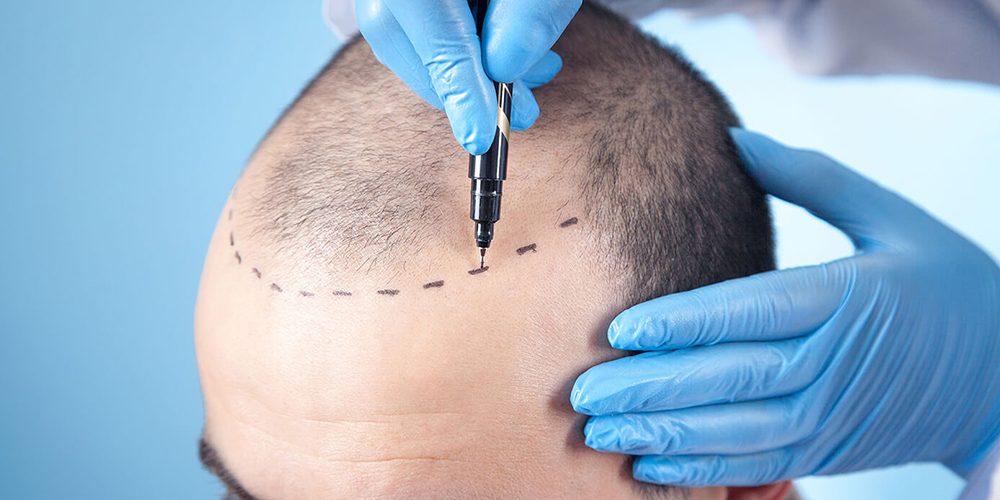- +91 97727 60561
- info@drdhabhai.in
- Wed - Sat: 5 PM - 8 PM Sunday Off

Hair loss is a common issue affecting millions of people worldwide, regardless of age or gender. It can significantly impact self-esteem, confidence, and the overall quality of life. For individuals experiencing severe hair loss, a hair transplant has emerged as a transformative solution, offering hope for a fuller and more natural-looking head of hair. This article explores the fascinating world of hair transplants, shedding light on the different techniques, advancements, benefits, and considerations of this innovative procedure.
Hair transplantation dates back to ancient civilizations, where rudimentary techniques were used to restore hair loss caused by various factors. Historical evidence from ancient Egypt to India and Japan showcases early attempts at hair restoration using methods like scalp flaps and grafts. However, it wasn’t until the late 20th century that hair transplantation saw significant progress with the introduction of modern surgical techniques.
Before delving into hair transplant techniques, it’s essential to understand the common causes of hair loss. Each type requires a tailored approach, from androgenetic alopecia (pattern baldness) to alopecia aerate (patchy hair loss) and traumatic hair loss. Genetic factors, hormonal imbalances, stress, and medical conditions all play a role in hair loss, making an accurate diagnosis and personalized treatment vital for successful outcomes.
Over the years, hair transplant procedures have evolved dramatically, offering patients a range of options based on their needs and preferences. The two primary techniques are:
FUT, also known as the strip method, involves surgically removing a strip of hair-bearing skin from the donor area (typically the back of the scalp) and dissecting it into individual hair follicles for transplantation. This method is suitable for patients with larger areas of baldness.
FUE involves harvesting individual hair follicles directly from the donor area using micro-punches. The minor wounds heal quickly, leaving minimal scarring, making FUE a preferred choice for patients who prefer a less invasive procedure and who may want to wear their hair short in the future.
Hair transplantation has witnessed remarkable advancements thanks to constant research and technological innovations. Some of the noteworthy developments include:
Robotic systems have been integrated into FUE procedures, offering precise and automated extraction of hair follicles. This minimizes the risk of human error and improves the efficiency of the transplant process.
PRP, derived from the patient’s blood, is used as a supportive therapy to promote hair growth and improve the overall success of hair transplantation.
Stem cells show promising potential in regenerating hair follicles and stimulating hair growth, providing a cutting-edge approach to restoration.
Before undergoing a hair transplant, patients must be adequately prepared for the procedure. This involves thorough consultations with a qualified hair transplant surgeon who will assess the patient’s hair loss pattern, discuss expectations, and outline the best-suited technique for optimal results.
On the day of the hair transplant, the patient will be administered local anesthesia to ensure a comfortable experience. The surgical team will meticulously extract individual hair follicles or a strip of hair-bearing skin based on the chosen technique. These harvested follicles are then carefully transplanted into the recipient area, adhering to natural hair growth patterns for a seamless and authentic look.
The recovery period following a hair transplant varies depending on the chosen technique. Patients may experience mild discomfort, swelling, and scabbing for a few days. Proper post-transplant care, including gentle cleansing, avoiding strenuous activities, and following the surgeon’s instructions, is crucial for optimal healing and hair growth.
Realistic expectations are essential when considering a hair transplant. While the results can be life-changing, they are not immediate. Patience is required as transplanted hairs will initially shed, and new hair growth will gradually emerge over the following months. With time, the transplanted hair blends seamlessly with the existing hair, providing a natural and undetectable outcome.
Hair loss is not limited to men; many women also suffer from the emotional impact of thinning hair. Female hair transplants have gained popularity as an effective solution for restoring hair density and enhancing confidence among women.
Hair transplant procedures are sometimes combined with other hair restoration treatments for enhanced results. This may include PRP therapy, laser hair therapy, or medications such as minoxidil and finasteride to prevent further hair loss and support the transplanted hairs.
Hair transplant procedures have revolutionized how we address hair loss, providing a renewed sense of confidence and self-esteem for individuals experiencing hair thinning and baldness. The advancements in techniques and supportive therapies offer promising prospects for those seeking a permanent and natural-looking solution. If you are considering a hair transplant, consult a qualified surgeon to explore your options and embark on the journey to restore your crowning glory and regain your self-assurance. Remember, a successful hair transplant not only changes your appearance but also transforms your life.